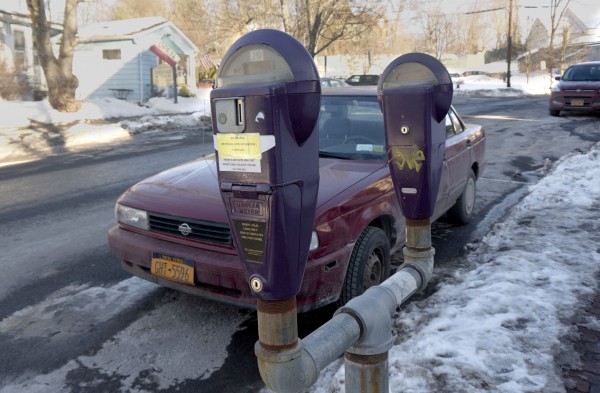
Seeking to alleviate parking issues in the Village of New Paltz, the village board has discussed potential ways to revamp conditions on residential roads — some neighboring the SUNY New Paltz campus — by exploring the feasibility of setting two-hour parking zones.
Village Board Trustee Sally Rhoads provided a detailed list of the board’s parking concerns at their Feb. 11 meeting, one which cited instances of drivers parking on residential streets for hours on end – some of which are SUNY New Paltz students in seek of parking spots adjacent to the school’s academic buildings.
According to Rhoads, many who live in residential neighborhoods near the campus are displeased with how many cars are constantly parked outside of their homes.
“If you are a student taking classes in Old Main, it is a lot easier to park on Ridge [Road] than to park in the big lot that has been created off of [Rt.] 32 — in addition to which, it’s free,” Rhoads said. “That’s one of the things we’re trying to weigh out because the residents who live on these streets where we have bumper-to-bumper parking now, are not happy.”
Third-year early education major Kristin Ludwig, a commuter student at SUNY New Paltz, believes that the root of these residential disruptions near the campus are due to the lack of parking provided for the students.
“The price of the campus parking pass is ridiculous because sometimes students can’t even find parking on campus,” she said. “I don’t think it is right to have to park on residential streets.”
To see which option could potentially alleviate this congestion on streets near the campus, the board drafted a plan to measure what impact a parking time limit would have on these areas — which currently do not garner any timed parking limitations.
The basis of this experiment would be to implement three two-hour and three four-hour parking limits on select residential streets for a period of six months time. Trustees suggested this six month period to span through multiple seasons to see how factors such as weather, tourism and student rush during the academic session would contribute to their results.
Gauging the areas where college commuters may be parking all day, Trustee Rebecca Rotzler suggested that if the board is permitted to conduct these tests, then streets such as South Oakwood, Lincoln Place, West Manheim Blvd., Ridge Road, Center Street and West Center Street should be among those chosen due to their proximity to the SUNY campus.
Rhoads said that the board consulted with the town attorney following the Feb. 11 meeting to see if this experiment could be conducted, but it was determined that this would not be a possibility unless legal parking codes were changed.
“I’m not sure where the board would be if it has to go through all the code changes in order to do the experiment, the experiment fails for whatever reason and then have to change the codes back,” Rhoads said. “I don’t know what the board will want to do with this information, but nothing is set yet — it is all just being discussed.”
Among other parking concerns addressed that evening, Rhoads also suggested that it would be useful if the village could measure the width of village streets to determine which streets are wide enough to allow two-way traffic and which are too narrow for it.
“I would think that those streets that are wide enough should have two-sided parking,” she said, also mentioning that streets that are too narrow should be changed to alternate side parking to allow for vehicles to pass through safely, allow room for Department of Public Works [DPW] projects and provide room for first responders in case of an emergency.
This topic of alternate side parking sparked traffic in the public comment section of the meeting, in which business owners and residents were in attendance to hear how some long-standing parking issues were to be discussed.
Village resident Alan Stout, who owns the North Front Street properties The Bakery and The Bicycle Rack, said he believes instituting alternate side parking on roads near his property would not be good for either of these businesses.
“We can’t afford a loss of parking,” Stout said.“Those parking spaces are vital to the North Front Street business community [and] if half of those spots are eliminated, those same people are still going to need parking.”
Stout also voiced concern about how instituting alternate-side parking on some village roads could become hazardous. When cars are parked on both sides of the road, he said, drivers are forced to slow down to permit the other cars on the road to pass by. If drivers no longer have to yield to other cars because there’s more room on the road, then they will be more apt to speed, Stout said.
Moving forward, Rhoads looks for the board to hold further discussion on all addressed parking concerns to see where any plans can be made to alleviate them.
“No matter what we decide, this has got to go to DPW, we’re going to ask the planning board what they think and the Transportation Implementation Committee,” Rhoads said. “This [first stage] is only our discussion and then it goes a lot of other places.”
